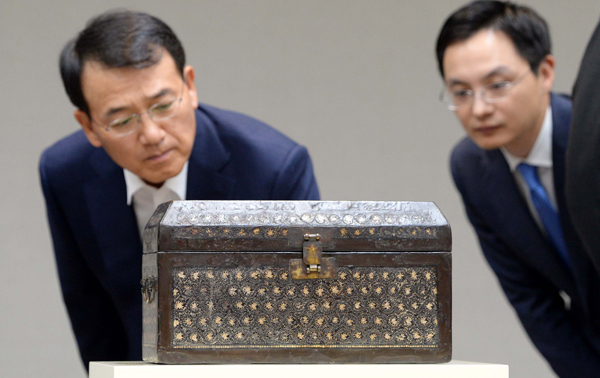Beautiful Buddhist box returns home to Korea

Najeon Gyeongham, a lacquered box inlaid with mother-of-pearl, was shown yesterday at the National Museum of Korea after it was donated to the museum. The container of Buddhist texts decorated with peony patterns is one of only nine boxes known to exist. Korea didn’t own one before yesterday. [NEWSIS] 국립중앙박물관은 새로 기증 받은 고려 시대의 나전경함, 즉 자개를 박은 옻칠 상자를 어제 공개했다. 불교 경전을 보관하기 위한 함으로써, 모란 당초 무늬가 주로 새겨져 있다. 현재 고려 나전경함은 전세계적으로 9개의 존재만 알려져 있으며, 이번 기증 전까지 국내에는 없었다. [뉴시스]
*mother-of-pearl: 자개
한국도 이제 전 세계에 9개만이 존재하는 고려시대의 나전경함을 보유하게 되었다.
The box, known as Najeon Gyeongham, was made during the Goryeo Dynasty (918-1392). “Gyeongham” means a box that holds Buddhist texts, while “najeon” is a Korean word indicating mother-of-pearl inlays. Until this year, no such box was in Korea.
*inlay: 무늬를 새겨 넣음, 상감 기법
고려시대에 만들어진 이 상자의 이름을 보면, 경함은 불교 경전을 보관하는 상자이고, 나전은 자개로 만들어진 장식을 뜻한다. 올해 이전까지만 해도, 국내에는 단 한 점도 없었다.
“It is very meaningful that Korea now has an item that represents the pinnacle of Goryeo-era arts,” said Kim Young-na, director general of the National Museum of Korea, which is the new home of the box.
*pinnacle: 정점, 절정
“고려시대 예술의 정수를 보여주는 물건을 한국도 보유하게 되었다는 데 의의가 큽니다,” 라고 이 나전경함을 보유하게 될 국립중앙박물관의 김영나 관장이 말했다.
The museum showed the box to local media yesterday.
국립중앙박물관은 어제 이 경함을 언론에 공개했다.
There are nine such boxes with inlaid shells of abalone known to exist. Two are owned by the Tokyo National Museum and one each by the British Museum in London, the Museum of Fine Arts in Boston, the Rijksmuseum in Amsterdam, the Kitamura Museum in Kyoto and the Tokugawa Art Museum in Nagoya. The final box is in a private collection in Japan.
*private collection: 개인 소장
전복껍질을 사용해서 장식된 이런 나전경함은 총 9점이 존재한다. 일본의 동경 박물관이 2 점을 보유하고 있고, 대영박물관이 한 점, 보스턴 미술관이 한 점, 암스테르담 미술관이 한 점, 교토의 기타무라 박물관이 한 점, 그리고 나고야의 도쿠가와 미술관이 한 점을 보유하고 있다. 마지막 한 점은 일본의 개인이 소장하고 있다.
Due to the fine inlay work, local experts speculate that these were popular trade items in the late Goryeo to early Joseon Dynasty (1392-1910).
*trade item: 교역 품목
정교한 장식으로 미루어보아, 국내 전문가들은 이 경함이 고려후기에서 조선 전기에 교역품으로 사용되었을거라고 추측한다.
The ninth box was purchased from a Japanese citizen by the Friends of the National Museum of Korea, a private support group, and donated to the museum yesterday.
*donate: 기증하다.
한국에 들어온 9번째 나전경함은 국립중앙 박물관의 후원기관인 국립중앙박물관회가 한 일본인에게서 구입한 것이다.
The box was auctioned in Japan in 2010 and a Japanese national bought it. Since then, the support group had numerous meetings with the Japanese collector to buy it.
*auction: 경매에 내놓다, 경매에 붙이다.
이 유물은 2010년에 일본에서 경매를 통해 판매되었고 이 일본인이 구매했다. 그 이후, 국립중앙박물관회가 일본인 구매자와 여러 번의 만남을 통해서 경함을 구매했다.
The wooden box is about 42 centimeters (16 inches) long, 20 centimeters wide and 23 centimeters high, just large enough to store a scroll. All of the surfaces of the box feature small flower patterns of peonies, one of the most common motifs for Goryeo lacquerware, made of mother-of-pearl. One flower is as small as a fingernail and the largest surface has around 100 flowers inlaid.
*scroll: 두루마리
나무로 만들어진 이 경함은 가로 42 센티미터, 세로 20 센티미터이고 높이는 23 센티미터로, 경전 두루마리 하나가 들어가기에 적당한 크기이다. 경함의 표면에는 작은 모란당초무늬가 새겨져있는데, 이 것은 고려 나전칠기에서 보이는 대표적인 자개로 만들어진 무늬이다. 꽃 무늬 하나는 손톱크기 정도로 작고, 제일 큰 표면에는 100개정도의 꽃 무늬가 새겨져있다.
“Each of the nine petals that make the shape of the peonies was separately inlaid onto the box to make a whole flower,” said Yi Yong-hee, senior conservator of the museum’s conservation science laboratory.
* conservation science laboratory: 보존과학연구소
“9개의 꽃잎으로 모란 당초무늬를 이루는데, 이 꽃잎은 각각 따로 장식되어서 하나의 꽃처럼 보이게 만들어졌습니다,” 라고 국립중앙 박물관의 이용희 학예사가 말했다.
“Given the fact that Goryeo didn’t have any tiny fretsaws, craftsmen had to work hard to make the box and that’s how Goryeo became known for its crafts.”
*fretsaw: 실톱
“고려시대에는 실톱이 없었던 것을 고려하면, 장인들의 엄청난 노력으로 이런 경함이 만들어진 것이고, 그것이 고려가 공예품으로 이름을 날릴 수 있었던 이유이다.”
There is only one other such box with peony patterns - in Kyoto, Japan. The other seven are inlaid with chrysanthemum patterns.
*peony: 모란, 작약
*chrysanthemum: 국화
이렇게 모란당초무늬로 장식된 경함은 세계에 단 한 점 더 존재한다. 다른 7점은 모두 국화무늬이다.
Goryeo craftsmen seem to have applied thin layers of lacquer before and after the patterns were inlaid onto the wooden box, according to Yi.
*lacquer: 광택제, 광택칠, 옻칠
이 학예사에 따르면, 고려의 장인들은 꽃장식을 상감하기 이전에 나무에 얇게 몇 겹으로 옻칠을 하고, 상감한 이후에 또 옻칠을 한 것으로 보인다고 했다.
Local experts estimate that the box was made toward the end of the Goryeo era, sometime in 12th or 13th century. Chiseled edges make the box look smoother, a distinct feature of Goryeo-era craftsmanship.
* chiseled edges: 끌로 다듬은 모서리
국내 전문가들은, 이 경함이 12세기에서 13세기 경인 고려후기에 만들어졌다고 보고 있다. 모서리가 부드럽게 마무리되어 있는데, 이것이 고려 공예의 특징이다.
Although a study of the box has not been completed, local experts have little doubt that it will be designated a National Treasure. As soon as the study is done, the museum will put the box on public display.
*National Treasure: 국보
이 경함에 관한 분석이 다 끝나지 않았지만, 국내 전문가들은 이 경함이 곧 국보로 지정될 것으로 내다봤다. 그리고 분석이 끝나는대로, 박물관은 경함을 일반에 공개할 예정이다.
번역: 이선민 문화부 기자 summerlee@joongang.co.kr










with the Korea JoongAng Daily
To write comments, please log in to one of the accounts.
Standards Board Policy (0/250자)